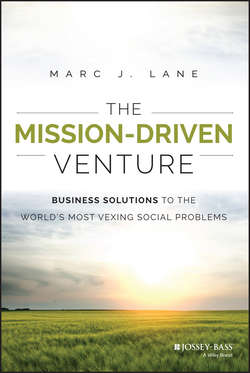Читать книгу The Mission-Driven Venture - Lane Marc J. - Страница 15
На сайте Литреса книга снята с продажи.
Chapter 2
Where to Begin? Constructing the Mission-Driven Venture
ОглавлениеThe mission-driven entrepreneur – whether a socially conscious individual, a member of a startup team, or a nonprofit's social enterprise champion – is likely to agree with management guru Jim Collins, the author of the groundbreaking bestseller Good to Great, who once observed that “When [what you are deeply passionate about, what you can be best in the world at and what drives your economic engine] come together, not only does your work move toward greatness, but so does your life.” But how does the mission-driven venture take shape?
A growing number of professionals are encouraging their entrepreneurial clients to forego formal business planning in favor of a “lean startup,” an alternative the mission-driven entrepreneur should seriously consider. After all, the conventional process – drafting a comprehensive business plan, pitching it to likely investors, recruiting talent, bringing a product or service to market, and lining up customers – hasn't worked very well. According to Harvard Business School's Shikhar Ghosh, as quoted in The Wall Street Journal, three-quarters of all startups fail. The odds are probably even worse for the mission-driven startup, balancing objectives including positive social change and its own financial sustainability.
To mitigate risk, proponents of the lean startup argue in favor of iterative business design rather than systematic business planning. Customer input is invited at an early stage so that the entrepreneur need not guess about whether or not a product or service would be well-received in the marketplace. Trial-and-error, which eventually reveals a marketable value proposition, takes the place of granular planning.
Lean startups reject the notion that an entrepreneur can realistically develop operating assumptions and financial forecasts – and divine the needs and wants of customers – before money has been raised or while the embryonic business idea has yet to be executed. Rather than guessing, the founder identifies the elements of his proposed business model as well as the hypotheses he'll need to test. Both are charted in Table 2.1.
Table 2.1 The Business Model's Elements and Hypotheses
Adapted from www.businessmodelgeneration.com/canvas. Canvas concept developed by Alexander Osterwalder and Yves Pigneur.
Once the hypotheses have been identified, the founder then goes out and determines empirically whether or not he can build a sustainable business around the product or service he envisions. Fully consistent with the mission-driven entrepreneur's unwavering commitment to both transparency and accountability, would-be customers and partners are canvassed about every aspect of the business model. Their reactions help inform the founder's course corrections, or “pivots,” to assumptions that will then be revised accordingly and presented in their new form for customers and partners to consider. While never forsaking research and analysis, the founder repeats the cycle as necessary – building, measuring, and learning – until consensus is reached. The idea is to validate customer interest in a “minimum viable product” (MVP) with just enough features to see whether it will work in the real world without the expense of building a “finished” product from scratch. The MVP is the right-sized product for the entrepreneur and his customer, big enough to invite customer adoption, satisfaction, and sales, but not so big as to be bloated and risky.
While traditional startups implement systematic business plans, lean startups are hypothesis-driven quests for the optimal business model. While traditional startups introduce products into the marketplace only after a step-by-step product development process is concluded, the lean startup – through the very process of testing hypotheses – is designing its product. Lean startups enlist early adopters, add employees as hypotheses are refined, and already have customers in place by the time their product is ready for wide distribution. This “hit the ground running” approach is likely to help the mission-driven entrepreneur innovate rapidly and eventually to transform business as we know it.
Maximizing the Prospects of Financial Success and Meaningful Social Impact
Still, those who contemplate launching a mission-driven venture face unique challenges and must take extra care to avoid a misstep, or even a calamity, and maximize the prospects of both financial success and meaningful social impact.
Конец ознакомительного фрагмента. Купить книгу
